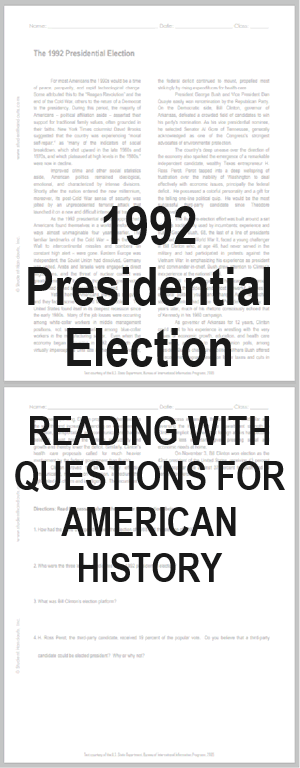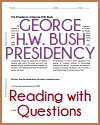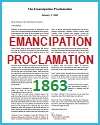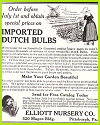| 1992 Presidential Election Reading with Questions |
|---|
| www.studenthandouts.com ↣ American History ↣ American History Readings |
|
For most Americans the 1990s would be a time of peace, prosperity, and rapid technological change. Some attributed this to the "Reagan Revolution" and the end of the Cold War, others to the return of a Democrat to the presidency. During this period. the majority of Americans—political affiliation aside—asserted their support for traditional family values, often grounded in their faiths. New York Times columnist David Brooks suggested that the country was experiencing "moral self-repair," as "many of the indicators of social breakdown, which shot upward in the late 1960s and 1970s, and which plateaued at high levels in the 1980s," were now in decline. Improved crime and other social statistics aside, American politics remained ideological, emotional, and characterized by intense divisions. Shortly after the nation entered the new millennium, moreover, its post-Cold War sense of security was jolted by an unprecedented terrorist attack that launched it on a new and difficult international track.  As the 1992 presidential election approached, Americans found themselves in a world transformed in ways almost unimaginable four years earlier. The familiar landmarks of the Cold War—from the Berlin Wall to intercontinental missiles and bombers on constant high alert – were gone. Eastern Europe was independent, the Soviet Union had dissolved, Germany was united, Arabs and Israelis were engaged in direct negotiations, and the threat of nuclear conflict was greatly diminished. It was as though one great history volume had closed and another had opened.
As the 1992 presidential election approached, Americans found themselves in a world transformed in ways almost unimaginable four years earlier. The familiar landmarks of the Cold War—from the Berlin Wall to intercontinental missiles and bombers on constant high alert – were gone. Eastern Europe was independent, the Soviet Union had dissolved, Germany was united, Arabs and Israelis were engaged in direct negotiations, and the threat of nuclear conflict was greatly diminished. It was as though one great history volume had closed and another had opened.Yet at home, Americans were less sanguine, and they faced some deep and familiar problems. The United States found itself in its deepest recession since the early 1980s. Many of the job losses were occurring among white-collar workers in middle management positions, not solely, as earlier, among blue-collar workers in the manufacturing sector. Even when the economy began recovering in 1992, its growth was virtually imperceptible until late in the year. Moreover, the federal deficit continued to mount, propelled most strikingly by rising expenditures for health care. President George Bush and Vice President Dan Quayle easily won renomination by the Republican Party. On the Democratic side, Bill Clinton, governor of Arkansas, defeated a crowded field of candidates to win his party's nomination. As his vice presidential nominee, he selected Senator Al Gore of Tennessee, generally acknowledged as one of the Congress's strongest advocates of environmental protection. The country's deep unease over the direction of the economy also sparked the emergence of a remarkable independent candidate, wealthy Texas entrepreneur H. Ross Perot. Perot tapped into a deep wellspring of frustration over the inability of Washington to deal effectively with economic issues, principally the federal deficit. He possessed a colorful personality and a gift for the telling one-line political quip. He would be the most successful third-party candidate since Theodore Roosevelt in 1912. The Bush re-election effort was built around a set of ideas traditionally used by incumbents: experience and trust. George Bush, 68, the last of a line of presidents who had served in World War II, faced a young challenger in Bill Clinton who, at age 46, had never served in the military and had participated in protests against the Vietnam War. In emphasizing his experience as president and commander-in-chief, Bush drew attention to Clinton's inexperience at the national level. Bill Clinton organized his campaign around another of the oldest and most powerful themes in electoral politics: youth and change. As a high-school student, Clinton had once met President Kennedy; 30 years later, much of his rhetoric consciously echoed that of Kennedy in his 1960 campaign. As governor of Arkansas for 12 years, Clinton could point to his experience in wrestling with the very issues of economic growth, education, and health care that were, according to public opinion polls, among President Bush's chief vulnerabilities. Where Bush offered an economic program based on lower taxes and cuts in government spending, Clinton proposed higher taxes on the wealthy and increased spending on investments in education, transportation, and communications that, he believed, would boost the nation's productivity and growth and thereby lower the deficit. Similarly, Clinton's health care proposals called for much heavier involvement by the federal government than Bush's. Clinton proved to be a highly effective communicator, not least on television, a medium that highlighted his charm and intelligence. The incumbent's very success in handling the end of the Cold War and reversing the Iraqi thrust into Kuwait lent strength to Clinton's implicit argument that foreign affairs had become relatively less important, given pressing social and economic needs at home. On November 3, Bill Clinton won election as the 42nd president of the United States, receiving 43 percent of the popular vote against 37 percent for Bush and 19 percent for Perot. Directions: Read the text above, then answer the questions below. Answers will vary. 1. How had the world changed between the election of 1988 and the election of 1992? 2. Who were the three leading candidates in the 1992 presidential election? 3. What was Bill Clinton's election platform? 4. H. Ross Perot, the third-party candidate, received 19 percent of the popular vote. Do you believe that a third-party candidate could be elected president? Why or why not? Click here to print. |
 |  |  |  |  |  |
| UNIT I: | Early America | UNIT IX: | Discontent and Reform | ||
| UNIT II: | Colonial Period | UNIT X: | War, Prosperity, and Depression | ||
| UNIT III: | American Revolution | UNIT XI: | New Deal and World War II | ||
| UNIT IV: | New National Government | UNIT XII: | Postwar America | ||
| UNIT V: | Westward Expansion | UNIT XIII: | Decades of Change | ||
| UNIT VI: | Sectional Conflict | UNIT XIV: | New Conservatism | ||
| UNIT VII: | Civil War and Reconstruction | UNIT XV: | Into the Twenty-first Century | ||
| UNIT VIII: | Growth and Transformation | UNIT XVI: | Polarization and Deglobalization |
| www.studenthandouts.com ↣ American History ↣ American History Readings |








